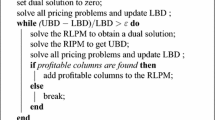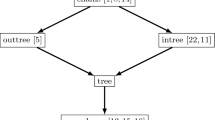Abstract
This paper addresses the flowshop group-scheduling problems typically encountered in the assembly of printed circuit boards in electronics manufacturing. A mathematical programming model is formulated to capture the characteristics inherent to group-scheduling problems experienced in electronics manufacturing as well as those common to a wide range of group-scheduling problems encountered in other production environments. Several heuristics, each incorporating different components that underlie the tabu search concept, are developed to solve this strongly NP-hard problem effectively in a timely manner. In order to investigate the quality of the heuristic solutions with respect to tight lower bounds, an effective and efficient decomposition approach is developed. The problem is decomposed into a master problem and single-machine subproblems, and a column generation algorithm is developed to solve the linear programming relaxation of the master problem. Branching schemes, compatible with the column generation subproblems, are employed to partition the solution space when the solution to the linear programming relaxation is not integral. Furthermore, tabu search based fast heuristics are implemented to solve the subproblems, and an effective stabilization method is developed to accelerate the column generation approach. An experimental design with both fixed and random factors accompanied by rigorous statistical analyses of computational tests conducted on randomly generated test problems as well as on a large size real industry problem confirm the high performance of the proposed approach in identifying quality lower bounds and strongly suggest its flexibility and applicability to a wide range of real problems.
Similar content being viewed by others
References
Amini, M. M., & Racer, M. A. (1994). Rigorous computational comparison of alternative solution methods for the generalized assignment problem. Management Science, 40(7), 868–890.
Anon. (2003). ILOG Branch&Price&Cut and shortest path optimizers prototype manual. Mountain View: Ilog Inc.
Anon. (2004a). ILOG CPLEX 9.0 reference manual. Mountain View: Ilog Inc.
Anon. (2004b). SAS: The SAS system for Windows. Cary: SSAS Institute Inc.
Balakrishnan, A., & Vanderbeck, F. (1999). A tactical planning model for mixed-model electronics assembly operations. Operations Research, 47(3), 395–409.
Barnhart, C., Johnson, E., Nemhauser, G., Savelsbergh, M., & Vance, P. (1998). Branch-and-Price: Column generation for solving huge integer programs. Operations Research, 46, 316–329.
Barr, R. S., Golden, B. L., Kelly, J. P., Resende, M. G. C., & Stewart, W. R. (1995). Designing and reporting on computational experiments with heuristic methods. Journal of Heuristics, 1, 9–32.
Bulbul, K., Kaminsky, P., & Yano, C. (2004). Flow shop scheduling with earliness, tardiness, and intermediate inventory holding costs. Naval Research Logistics, 51, 407–445.
Chen, Z. L., & Powell, W. (1999). Solving parallel machine scheduling problems by column generation. INFORMS Journal on Computing, 11, 78–94.
Coffin, M., & Saltzman, M. J. (2000). Statistical analysis of computational tests of algorithms and heuristics. INFORMS Journal on Computing, 12(1), 24–44.
Crama, Y., van de Klundert, J. J., & Spieksma, F. C. R. (2002). Production planning problems in printed circuit board assembly. Discrete Applied Mathematics, 123, 339–361.
du Merle, O., Villeneuve, D., Desrosiers, J., & Hansen, P. (1999). Stabilized column generation. Discrete Mathematics, 194, 229–237.
Eom, D. H., Shin, H. J., Kwun, I. H., Shim, J. K., & Kim, S. S. (2002). Scheduling jobs on parallel machines with sequence-dependent family set-up times. International Journal on Advanced Manufacturing Technology, 19, 926–932.
Garey, M. R., Johnson, D. S., & Sethi, R. R. (1976). The complexity of flowshop and jobshop scheduling. Mathematics of Operations Research, 36, 767–777.
Gelogullari, C. A. (2005). Group scheduling problems in electronics manufacturing. Doctoral dissertation, Oregon State University, Corvallis, OR, USA.
Glover, F., & Laguna, M. (1997). Tabu search. Boston: Kluwer Academic.
Gopalakrishnan, M., Ding, K., Bourjolly, J. M., & Mohan, S. (2001). A tabu-search heuristic for the capacitated lot sizing problem with set-up carryover. Management Science, 47, 851–863.
Hayrinen, T., Johnsson, M., Jahletta, T., Smed, J., & Nevalainen, O. (2000). Scheduling algorithms for computer-aided line balancing in printed circuit board assembly. Production Planning and Control, 11, 497–510.
Hooker, J. N. (1994). Needed: An empirical science of algorithms. Operations Research, 42(3), 201–212.
Johnson, M., & Smed, J. (2001). Observations on PCB assembly optimization. Electronic Packaging and Production, 28, 1871–1883.
Kanet, J. J., & Sridharan, V. (2000). Scheduling with inserted idle time: problem taxonomy and literature review. Operations Research, 48, 99–110.
Leon, V. J., & Peters, B. A. (1996). Replanning and analysis of partial setup strategies in printed circuit board assembly systems. International Journal of Flexible Manufacturing Systems, 8, 389–412.
Logendran, R., & Sonthinen, A. (1997). A tabu search-based approach for scheduling job-shop type flexible manufacturing systems. Journal of the Operational Research Society, 48, 264–277.
Logendran, R., & Subur, F. (2004). Unrelated parallel machine scheduling with job splitting. IIE Transactions, 6(4), 359–372.
Maimon, O., & Schtub, A. (1991). Grouping methods for printed circuit boards. International Journal of Production Research, 29, 1370–1390.
McGinnis, L. F., Ammons, J. C., Carlyle, M., Cranmer, L., Depuy, G. W., Ellis, K. P. Tovey, C. A. & Xu, H. (1992). Automated process planning for printed circuit card assembly. IIE Transactions, 24, 18–30.
Montgomery, D. C. (2005). Design and analysis of experiments. New York: Wiley.
Rossetti, M. D., & Stanford, K. J. A. (2003). Group sequencing a PCB assembly system via an expected sequence dependent setup heuristic. Computers and Industrial Engineering, 45(1), 231–254.
Savelsbergh, M. (1997). A branch-and-price algorithm for the generalized assignment problem. Operations Research, 45, 831–841.
Schaller, J. E. (2001). A new lower bound for the flow shop group scheduling problem. Computers and Industrial Engineering, 41, 151–161.
Smed, J., Salonen, K., Johnsson, M., Johletta, T., & Nevalainen, O. (2004). Grouping PBCs with minimum feeder changes. International Journal of Flexible Manufacturing Systems, 15, 19–35.
Sox, C. R., & Gao, Y. (1999). The capacitated lot sizing problem with setup carry-over. IIE Transactions, 31, 173–181.
Strusevic, V. A. (2000). Group technology approach to the open shop scheduling problem with batch setup times. Operations Research Letters, 26, 181–192.
Suerie, C., & Stadtler, H. (2003). The capacitated lot-sizing problem with linked lot sizes. Management Science, 49, 1039–1054.
Tang, C. S., & Denardo, E. V. (1988). Models arising from a flexible manufacturing machine, part 1: Minimization of the number of tool switches. Operations Research, 36, 767–777.
Van den Akker, J., Hoogeven, J., & Van de Velde, S. (1999). Parallel machine scheduling by column generation. Operations Research, 47, 862–872.
Vanderbeck, F., & Wolsey, L. (1996). An exact algorithm for IP column generation. Operations Research Letters, 19, 151–159.
Author information
Authors and Affiliations
Corresponding author
Rights and permissions
About this article
Cite this article
Gelogullari, C.A., Logendran, R. Group-scheduling problems in electronics manufacturing. J Sched 13, 177–202 (2010). https://doi.org/10.1007/s10951-009-0147-3
Published:
Issue Date:
DOI: https://doi.org/10.1007/s10951-009-0147-3




